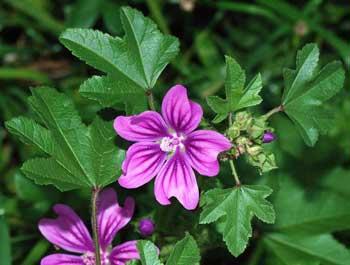Contents:
Common Names | Parts Usually Used | Plant(s) & Culture | Where Found | Medicinal Properties | Biochemical Information
Legends, Myths and Stories | Uses | Formulas or Dosages | Nutrient Content | Bibliography
Scientific Names

- Malva sylvestris L.
- Malvaceae
- Mallow family
Common Names
- Cheeseflower
- Common mallow
- Country mallow
- Malva
Parts Usually Used
The whole herb
Back to Top

Description of Plant(s) and Culture
High mallow is an annual or perennial; the tapering, whitish root produces a round stem, 2 to 3 feet high, with alternate, light green, downy leaves which are 5 to 7 lobed. The pink or purple axillary flowers have 5 narrow petals and appear from May to October.
Another variety: Low mallow (M. rotundifolia) is used the same as high mallow.
Back to Top
Where Found
Found in waste places, rubbish dumps, fields, and along fences and roadsides, as well as cultivated. In Europe, Canada, and Mexico. Native of Europe, naturalized to North America.
Back to Top
Medicinal Properties
Astringent, demulcent, emollient, expectorant, cathartic
Back to Top
Biochemical Information
Mucilage, vitamin C, sugar, minerals, keratin, and coloring matter
Back to Top
Legends, Myths and Stories
Pliny wrote, “anyone taking a spoonful of mallows will be free of disease.”
The Chinese eat the leaves raw in salads or boiled like spinach.
Back to Top
Uses
Makes a good demulcent tea (soothing the mucus membranes) for coughs, hoarseness, bronchitis, inflammation of the larynx and tonsils, colds, laryngitis, emphysema, lung catarrh, gastritis, ague, laxative, dyspepsia, cystitis, and inflammation of the colon. Externally, a decoction can be used to wash wounds and sores. Make a poultice of the herb to soothe irritations and inflammations. A warm enema made from the leaves is helpful for intestinal inflammation.
Back to Top
Formulas or Dosages
Use the fresh plant only.
Infusion: add 1 to 2 tsp. herb to 1/2 cup cold water. Let stand for 8 hours, then warm up to lukewarm. (Do not boil or steep the herb in boiling water). Drink 1 to 2 cups daily.
Decoction: For external use, boil 1 tbsp. herb in 1/2 cup water for a short time.
Back to Top
Nutrient Content
Sugar, minerals, vitamin C, keratin
Back to Top
Bibliography
![]() The Herb Book
The Herb Book, by John Lust, Bantam Books, 666 Fifth Avenue, New York, NY. copyright 1974.
Herbal Gardening, compiled by The Robison York State Herb Garden, Cornell Plantations, Matthaei Botanical Gardens of the University of Michigan, University of California Botanical Garden, Berkeley., Pantheon Books, Knopf Publishing Group, New York, 1994, first edition
![]() American Folk Medicine
American Folk Medicine, by Clarence Meyer, Meyerbooks, publisher, PO Box 427, Glenwood, Illinois 60425, 1973
![]() Culpeper’s Complete Herbal & English Physician: Updated With 117 Modern Herbs
Culpeper’s Complete Herbal & English Physician: Updated With 117 Modern Herbs, by Nicholas Culpeper, Meyerbooks, publisher, PO Box 427, Glenwood, Illinois 60425, 1990, (reprint of 1814)
![]() Indian Herbalogy of North America
Indian Herbalogy of North America, by Alma R. Hutchens, Shambala Publications, Inc., Horticultural Hall, 300 Massachusetts Avenue, Boston, Massachusetts 02115, 1973
![]() Eastern/Central Medicinal Plants
Eastern/Central Medicinal Plants, by Steven Foster and James A. Duke., Houghton Mifflin Company, 215 Park Avenue South, New York, NY 10000
![]() The Nature Doctor: A Manual of Traditional and Complementary Medicine
The Nature Doctor: A Manual of Traditional and Complementary Medicine, by Dr. H.C.A. Vogel; Keats Publishing, Inc., 27 Pine Street (Box 876) New Canaan, CT. 06840-0876. Copyright Verlag A. Vogel, Teufen (AR) Switzerland 1952, 1991
